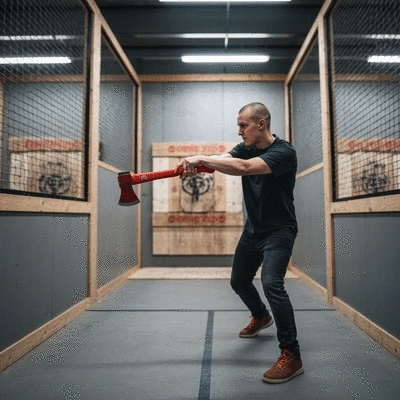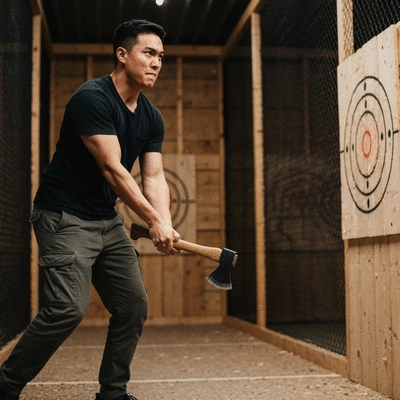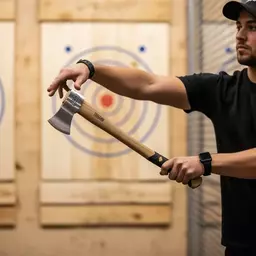Oct 26
One-Handed or Two-Handed Axe Throwing?
What if choosing the right axe throwing technique could elevate your game from novice to expert? Understanding the differences between one-handed and two-handed techniques can significantly enhance your throwing experience. Dive into the insights below to discover which style suits you best!
What You Will Learn
- One-Handed Throwing: Offers greater mobility and a quicker release, making it ideal for casual play and for those seeking agility.
- Two-Handed Throwing: Provides enhanced power and control, beneficial for achieving greater accuracy and distances.
- Common Misconceptions: One-handed throwing is not just for beginners, and two-handed throws do not always guarantee better accuracy.
- Experimentation is Key: Your comfort level should guide your choice; switch between techniques depending on the situation for optimal results.
Axe Throwing Techniques: One-Handed vs. Two-Handed
This visual compares the key characteristics, advantages, and ideal use cases for one-handed and two-handed axe throwing techniques. If you're just starting, a beginner's guide to axe throwing can help you grasp the basics before diving into these techniques.
One-Handed Throwing
- • More mobility & natural feel
- • Quicker release
- • Often favored in casual settings
- • Easier for beginners to grasp
Two-Handed Throwing
- • Greater power & control
- • Enhanced stability for accuracy
- • Perfect for greater distances
- • Ideal for maximum force
Understanding Axe Throwing Techniques: One-Handed vs. Two-Handed
Axe throwing is an exciting sport that offers various techniques to help you hit that sweet bullseye! Among the most commonly debated styles are the one-handed and two-handed techniques. Each has its own unique approach, advantages, and challenges. So, what sets them apart, and how do you choose the right one for you? Let’s dive into the details!
At Axe Throwing Guide, we believe understanding these techniques is crucial for both beginners and seasoned throwers. Whether you prefer the simplicity of one-handed throws or the stability offered by two-handed techniques, knowing the fundamentals will enhance your overall experience.
Defining the Techniques: What Sets One-Handed and Two-Handed Axe Throwing Apart?
The primary difference between one-handed and two-handed axe throwing lies in the grip and body mechanics used during the throw. With one-handed throwing, you gain greater mobility and a more natural feel. It allows for a quicker release and is often favored in casual settings. On the other hand, two-handed throwing provides more power and control, which can be beneficial when aiming for accuracy. For more detailed insights on venues that cater to both styles, check out our guide on axe throwing venues across Australia.
- One-Handed: More mobility, quicker release, and a relaxed feel.
- Two-Handed: Greater power, enhanced control, and often preferred for precision.
Choosing the right technique often depends on your personal comfort and the type of throwing experience you're looking for. Some throwers even switch between the two styles depending on the situation!

Common Misconceptions about Axe Throwing Techniques
There are a few misconceptions that can steer you away from mastering either technique. One of the biggest myths is that one-handed throwing is only for beginners. In reality, many skilled throwers use this style effectively! Conversely, some believe that two-handed throws are always more powerful, but if executed poorly, they can lead to inaccuracies.
- Myth 1: One-handed throws are only for beginners.
- Myth 2: Two-handed throws guarantee better accuracy.
- Myth 3: You can't switch between techniques.
By understanding these myths, you can develop a more informed approach to your axe throwing journey, leading to a more enjoyable and successful experience!
Pro Tip
To maximize your throwing accuracy, focus on your follow-through. After releasing the axe, let your arm continue the motion as if you were reaching toward your target. This not only improves your aim but also helps build muscle memory for consistent throws!
Wrapping Up Your Axe Throwing Journey: Which Technique Suits You Best?
As we've explored throughout this guide, mastering both one-handed and two-handed axe throwing techniques offers unique advantages and challenges. By understanding the differences, you can make an informed choice about which method resonates with your style and comfort level. So, let’s summarize the key takeaways!
Summarizing Key Takeaways: One-Handed vs. Two-Handed Techniques
- One-Handed Throwing: Ideal for those seeking agility and a lighter feel. It encourages precision and can be easier for beginners to grasp.
- Two-Handed Throwing: Provides maximum control and power, perfect for those looking to achieve greater distances and more force behind each throw.
- Personal Preference: Ultimately, your choice may come down to which technique feels more comfortable and natural for you. Experimentation is key!
Each style has its merits, and the best way to find out what works for you is through practice. Remember, as you dive into your axe throwing journey, enjoy the process! It’s all about having fun and connecting with your fellow enthusiasts.
Next Steps: How to Practice and Improve Your Axe Throwing Skills
Now that you have a solid understanding of both techniques, it's time to focus on practice! Here are some actionable steps to enhance your skills:
- Regular Practice: Consistency is key. Set aside time each week to practice your throwing technique, whether it’s one-handed or two-handed.
- Join a Local League: Engaging with a community of throwers can provide valuable feedback and tips. Plus, it’s a great way to meet fellow enthusiasts!
- Record Your Progress: Keep track of your throws and improvements. This can help you identify patterns and areas that need more focus.
- Seek Feedback: Don’t hesitate to ask for tips from more experienced throwers. Their insights can help you refine your technique.
As I always say at Axe Throwing Guide, it's not just about hitting the bullseye; it's about enjoying the journey! So grab your axe, head to the range, and let’s make some unforgettable memories. For those interested in competitive throwing, our axe throwing competition prep guide offers valuable strategies.

Join the Conversation: Share Your Axe Throwing Experience
Encouraging Reader Engagement: Questions and Feedback
I want to hear from you! What has your experience been like while learning to throw axes? Have you found one technique to be more suitable for your style? Feel free to share your thoughts and questions in the comments below!
Your stories not only enrich our community, but they also inspire others who are just starting out. Let’s keep the conversation going and support each other in our axe throwing adventures!
Recap of Key Points
Here is a quick recap of the important points discussed in the article:
- One-Handed Throwing: Ideal for those seeking agility and a lighter feel. It encourages precision and can be easier for beginners to grasp.
- Two-Handed Throwing: Provides maximum control and power, perfect for those looking to achieve greater distances and more force behind each throw.
- Personal Preference: Your choice may come down to which technique feels more comfortable and natural for you. Experimentation is key!
- Regular Practice: Consistency is essential. Set aside time each week to practice your throwing technique.
- Join a Local League: Engaging with a community of throwers can provide valuable feedback and tips.
- Seek Feedback: Asking for tips from more experienced throwers can help refine your technique.
Frequently Asked Questions (FAQs)
Q: What is the main difference between one-handed and two-handed axe throwing?
A: One-handed throwing offers greater mobility and a quicker release, often preferred for a natural feel and agility. Two-handed throwing provides enhanced power and control, beneficial for increased accuracy and greater distances.
Q: Is one-handed axe throwing only for beginners?
A: No, this is a common misconception. Many skilled throwers effectively use the one-handed technique, finding it suitable for precision and agility.
Q: Does two-handed throwing always guarantee better accuracy?
A: While two-handed throwing offers enhanced stability and control, better accuracy is not guaranteed if the technique is executed poorly. Consistency and practice are key, regardless of the style.
Q: Can I switch between one-handed and two-handed techniques?
A: Yes, many throwers switch between one-handed and two-handed styles depending on their personal comfort, the situation, or the specific axe they are using. Experimentation is highly encouraged to find what works best for you.
Q: What are some tips for improving axe throwing skills?
A: Key tips include regular practice, joining a local league for feedback and community, recording your progress to identify areas for improvement, and seeking advice from more experienced throwers.

Jacklyn Ames
Axe Throwing Enthusiast. Founder of Axe Throwing Guide. Inspiring the thrill of the throw.
Jacklyn Ames is dedicated to transforming beginners into confident axe throwers, providing expert insights and safety tips, empowering enthusiasts across Australia to embrace a thrilling, social activity. Join her on our blog for daily tips and tailored strategies that simplify your axe throwing journey and enhance your skills.


